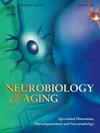激活 M1 肌激酶受体可逆转小鼠与年龄相关的记忆更新损伤。
IF 3.7
3区 医学
Q2 GERIATRICS & GERONTOLOGY
引用次数: 0
摘要
先前巩固的记忆在重新激活时会变得暂时不稳定。基于再激活的记忆更新主要是在年轻受试者身上进行研究的,因此我们的目标是评估整个生命周期的这一过程。为此,我们开发了一种行为范式,用上下文信息更新重新激活的物体记忆;3 个月大和 6 个月大的雄性 C57BL/6 小鼠显示出物体记忆更新,而 12 个月大的小鼠则没有。我们发现,在重新激活过程中,M1毒蕈碱乙酰胆碱受体信号对于幼鼠的物体记忆更新是必要的。接下来,我们针对这一机制尝试促进衰老小鼠的物体记忆更新。值得注意的是,全身药理激活 M1 受体可以逆转与年龄相关的记忆缺失。对脑周皮层内胆碱能系统标记物的定量分析发现了微妙的细胞变化,这些变化可能是造成不同年龄组小鼠表现差异的原因。这些研究结果表明,胆碱能在整个生命周期中的自然变化是导致老龄大脑记忆不灵活的原因之一。本文章由计算机程序翻译,如有差异,请以英文原文为准。
M1 muscarinic receptor activation reverses age-related memory updating impairment in mice
Previously consolidated memories can become temporarily labile upon reactivation. Reactivation-based memory updating is chiefly studied in young subjects, so we aimed to assess this process across the lifespan. To do this, we developed a behavioural paradigm wherein a reactivated object memory is updated with contextual information; 3-month-old and 6-month-old male C57BL/6 mice displayed object memory updating, but 12-month-old mice did not. We found that M1 muscarinic acetylcholine receptor signaling during reactivation was necessary for object memory updating in the young mice. Next, we targeted this mechanism in an attempt to facilitate object memory updating in aging mice. Remarkably, systemic pharmacological M1 receptor activation reversed the age-related deficit. Quantification of cholinergic system markers within perirhinal cortex revealed subtle cellular changes that may contribute to differential performance across age groups. These findings suggest that natural cholinergic change across the lifespan contributes to inflexible memory in the aging brain.
求助全文
通过发布文献求助,成功后即可免费获取论文全文。
去求助
来源期刊

Neurobiology of Aging
医学-老年医学
CiteScore
8.40
自引率
2.40%
发文量
225
审稿时长
67 days
期刊介绍:
Neurobiology of Aging publishes the results of studies in behavior, biochemistry, cell biology, endocrinology, molecular biology, morphology, neurology, neuropathology, pharmacology, physiology and protein chemistry in which the primary emphasis involves mechanisms of nervous system changes with age or diseases associated with age. Reviews and primary research articles are included, occasionally accompanied by open peer commentary. Letters to the Editor and brief communications are also acceptable. Brief reports of highly time-sensitive material are usually treated as rapid communications in which case editorial review is completed within six weeks and publication scheduled for the next available issue.
 求助内容:
求助内容: 应助结果提醒方式:
应助结果提醒方式:


